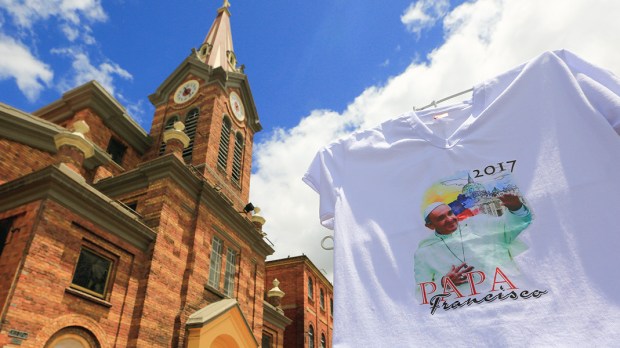The motto for Pope Francis’ Sept. 6-11 visit to Colombia is “Let’s take the first step,” and it is not just a carefully crafted marketing slogan. It is a declaration of intent and the guiding principle behind the papal visit.
Pope Francis announced his wish to visit the country back in 2016. But he said he would not visit until a much sought-after peace deal was locked down. That deal between the Colombian government and the Revolutionary Armed Forces of Colombia (FARC) was signed on Nov. 12, 2016 (after an initial deal in June failed a referendum vote in October). With that, 53 years of war essentially came to an end and the papal visit became possible.
But for Colombia to enjoy long-term peace, there are some outstanding issues to deal with: another significant guerrilla group has yet to sign a peace deal, the issue of paramilitary forces has not been addressed, and in general a nationwide reconciliation is needed.
An estimated 220,000 people were killed and, according to Human Rights Watch, more than 6.8 million Colombians were internally displaced during the protracted war. As the head of the FARC, Rodrigio Londono Echeverri, pointed out during an appearance on a Colombian TV talk show, a “culture of violence” had been created in the country.
Pope Francis’ visit is being billed as the first step in what will be a long process of changing that culture of violence. His upcoming visit has already delivered some concrete progress towards peace.
The National Liberation Army (ELN) — which was once led by priests — has not yet signed a peace deal but may be ready to call a ceasefire. Reuters reported on August 10 that ELN leaders could call a ceasefire for the pope’s visit. Pablo Beltran, the ELN’s chief negotiator, said it would be “a gesture” to recognize the support Pope Francis has given the Colombian peace process.
During Pope Francis’ five-day visit to the country, his itinerary will include several events designed to draw Colombians together, recognize the sins of the past, and motivate them to do what they can to pave the way for long-term peace.
Martyrs
Those events include a September 8 Mass in Villavicencio during which the pope will beatify two Colombian martyrs: Bishop Jesús Emilio Jaramillo Monsalvé and Pedro Maria Ramirez, a country priest. Both were killed as a result of the violence that engulfed the nation for decades.
Bishop Jaramillo Monsalvé was killed in 1989. His car was stopped by members of the National Liberation Army (ELN) and his travel companion was sent away with orders to return the next morning. Daylight brought the discovery of the bishop’s body with signs of multiple gunshot wounds. The ELN guerrillas later said they killed the bishop because he was a part of a conservative branch of the Church hierarchy.
The country priest, Fr. Ramirez, was assigned to a parish in Armero, Tolima. He was killed in 1948 in the violence that erupted after the liberal politician and presidential candidate Jorge Eliecer Gaitan was killed. In retaliation, Gaitan’s supporters in Armero lynched Fr. Ramierez, claiming he was a fanatic conservative whom they considered dangerous.
The same day he beatifies the two martyrs, Pope Francis will lead a prayer service for national reconciliation and visit the reconciliation cross that stands in the Park of the Founders in Villavicencio.
On the last day of his trip, Pope Francis will be in Cartagena where he will visit the St. Peter Claver sanctuary, a museum and church located in what was once the Jesuit house, to lead the Angelus and meet with representatives of the local Afro-Colombian community.
St. Peter Claver was a Jesuit missionary from Spain who arrived in Cartagena in 1610 to minister to slaves and the poor. An estimated 10,000 slaves were brought to Colombia every year through the port of Cartagena. Claver would board the ships before they docked to tend to the slaves’ needs, even baptizing the new arrivals so it would be easier to convince their owners to treat them humanely. Claver caught the plague in 1651 and was bedridden the last few years of his life. When he died in 1654, locals stripped his bedroom of everything except the bed linens in order to have relics of the man they considered a saint.
The rest of the pope’s itinerary includes events that are fairly standard on papal trips: courtesy visits with local authorities, meetings with local bishops and with men and women religious, a visit to a center that helps the poor, and a brief meeting with young people. Given the context in which those “usual” events are taking place, expect to hear Pope Francis tell each of these groups exactly how they can contribute to lasting peace in Colombia and give them the boost of energy they need to make that peace happen.

